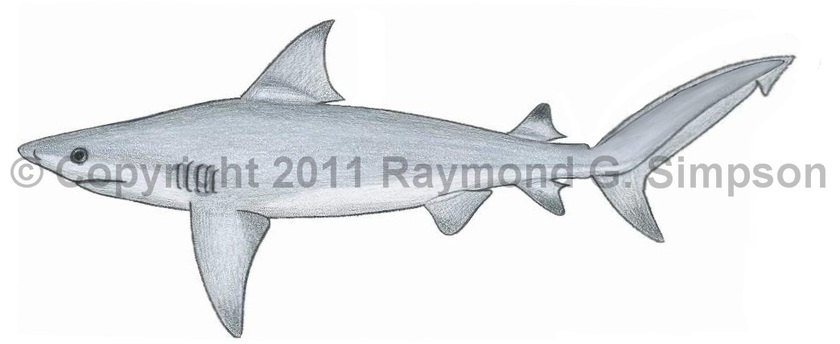
Common Name
Bull Shark
Year Described
Müller and Henle, 1839
Identification
Anteroposterior tooth rows: 12-14/12-13 on each side; 25-29/25-27 total
Vertebrae: 101-103 precaudal, 198-227 total
A large and robust shark with a short and rounded snout. Eye small. Distance between nostrils 0.7-1.0 times in pre-oral distance. Nasal flaps broadly triangular and low. Upper labial furrows very short. Interdorsal ridge is absent. Long preanal ridge absent. No keels on caudal peduncle. Gill slits long (3.1-4.5% TL). Teeth in upper jaws triangular and heavily serrated, with straight to slightly concave edges. Lower jaw teeth with angled shoulders, and thick, serrated, and erect cusps. First dorsal fin fairly high and broad (7.0-10.8% TL) with a convex or straight anterior margin, a pointed tip, and inserted just posterior to origin of pectoral fin. Second dorsal fin much smaller (3.2-4.5% TL) and inserted slighly before anal fin. Both dorsal fins with extended free posterior tips (second dorsal free tip very short; less than fin height). Anal fin similar in size to second dorsal fin. Pelvic fin origin well behind free tip of first dorsal. Pectoral fin large and broad, with a pointed tip.
Color
Body gray above, abruptly whitish below. Fins with dusky tips in adults and black in juveniles.
Size
Mature adults from 157-260cm TL. Newborns from 56-81cm. Maximum size to 340cm TL.
Habitat
Found from 1-150m, but mostly in shallow coastal waters <30m over the bottom. Tolerates a wide range of salinities and is the only western Atlantic shark that regularly enters freshwater (sometimes far up rivers and in lakes). Common at all sizes in estuaries and lagoons.
Range
Massachusetts to Argentina, including the Gulf of Mexico and the entire Caribbean Sea. Also coastal rivers in the tropics and subtropics, and Lake Nicaragua.
References
Castro, J.I. 2011. The Sharks of North America. Oxford University Press, 640 pp.
Compagno, L.J.V. 2002. Sharks. In: Carpenter, K.E. (Editor) FAO Identification Guide for Fishery Purposes. The Living Marine Resources of The Western Central Atlantic. Volume 1: Introduction, mollusks, crustaceans, hagfishes, sharks, batoid fishes, and chimaeras. ASIH Special Publication No. 5. FAO, Rome.
Compagno, L., M. Dando, and S. Fowler. 2005. Sharks of the World. Princeton University Press, 480 pp.